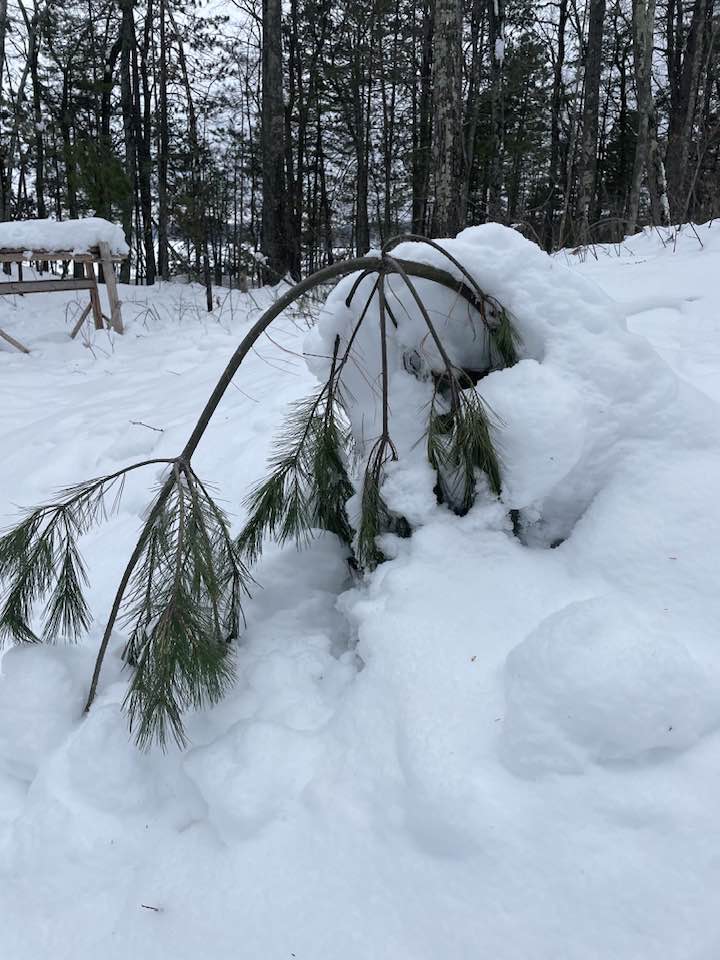JANUARY 2, 2023 – The pre-Christmas weather that besieged the country, smashed indiscriminately through our woods. From a comfortable distance we worried about power, plumbing and heating at the Red Cabin. Trees and wildlife, meanwhile, took a beating. The first visible casualties were four 30-year-old Norways that we’d planted on conservancy land near the entrance to the “back-back-road.” They lay facedown like splintered matchsticks. Fresh, jagged stumps poking four feet above the snowline stood as tragic memorials of once perfect pine. I felt heartsick.
Our long, winding drive was carpeted with pine needle clusters, and on the final approach, where sentinel pines stand guard, branches the size of adolescent trees lay strewn in disarray. I stopped to pull the boughs aside and to see whence Boreas had ripped them from their age-old lookouts. Jagged stubs 40 feet up told of violent amputation.
Closer to the cabin, I found more devastation. A royal Norway as old as our dwelling and a pleasure to behold, had been deposed by the storm. Not far from the foot of the pine, I found its toppled crown—four years of luxuriant growth and the promise of a popular royal’s reign. Nearly every surrounding birch, once straight and tall was now caught in a frozen bow to earth, held in silent struggle against winter’s wrath. But in an image of hope, the twin firs by the cabin corner had survived, their well-shaped tops intact in defiance of the heavy snow that imprisoned their lower branches.
Later, with trepidation I followed a deer trail back into Björnholm Trädgården, where in late October I’d bud-capped 1,200 young white pine. The scene was unrecognizable. Nearly every tree was buried completely or nearly so, bent 90 degrees or all the way down, its top buried deep in snow. I wanted urgently to rescue every victim, but I also knew how futile and possibly harmful the effort would be. Such a mission would take till March, and I risked snapping trunks and branches in freeing them from ice- and snow-bound incarceration. To avoid more anguish, I chose not to wonder about all the bud caps, their individual fates obscured until . . . spring?
Meanwhile, back closer to the cabin, I found Byron and Mylène’s wedding tree nearly decimated by famished deer. The badly wounded tree will survive, I told myself, desperate to believe it. In previous years I’d placed a barricade around the hemlock to protect it from cervine marauders but made an exception this year, so focused was I on the white pine. As I retraced my steps back out, I saw them filled with guilt.
Yesterday, while Byron, Mylène and I were retrieving oak firewood in the tree garden, I noticed where deer had lain, compressing the snow. I pictured them hunkered down stoically against the storm, senses assaulted by howling wind driving ice and snow.
Eventually, however, I came to terms with nature’s devastation wreaked upon itself. Winter’s vicious toll against the trees was beyond my control. Furthermore, over years I’ve witnessed countless cases of arboreal resilience. Like Ukrainians bent low by a madman’s rage battle back against the odds, so will the trees, alone and together, recover from winter’s fury. Nature’s own psychotic outburst, just like Putin’s, will unleash restorative willpower, all part of a cycle of annihilation and reconstruction, as “natural” in the woods as among humanity.
(Remember to subscribe to this blog and receive notifications of new posts by email.)
© 2023 by Eric Nilsson
